Battle-scarred fortresses, grand palaces, golden sand dunes, colourful culture and friendly folk combine to make this desert state a must-visit destination
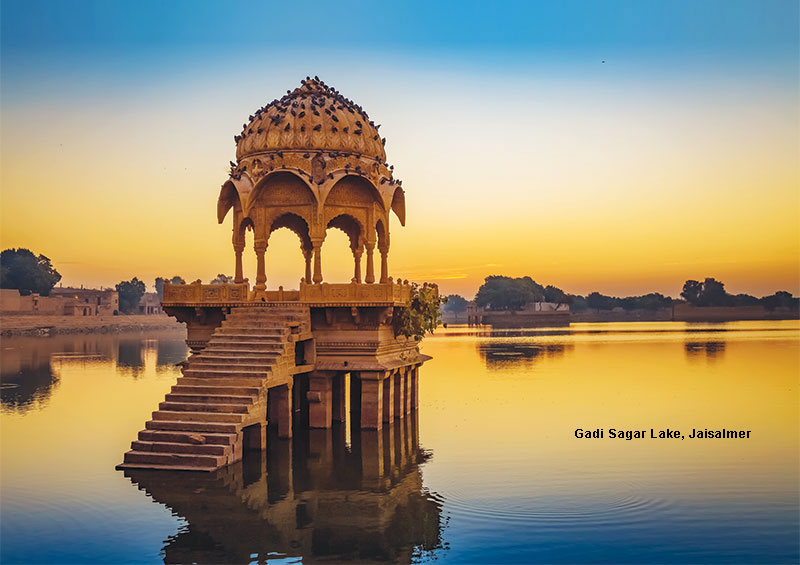
The erstwhile royal state of Rajasthan is visited by millions of Indian and foreign tourists every year — 4.75 million Indian and foreign tourists visited Rajasthan (pop. 69 million) in 2017. Of them 1.61 million were foreign tourists from around the world. Not as much for the intrinsic charm of this backward desert state as for the exotic, world famous ‘golden triangle’ package — Delhi-Agra-Jaipur-Delhi — offered by all tour operators. Its battle-scarred fortresses, grand palaces, golden sand dunes, colourful culture and friendly folk make it a must-visit destination of every traveller.
The state’s original inhabitants were Rajputs — a warrior clan that ruled over this part of India for more than 1,000 years, adhering to a code of chivalry and honour akin to that of medieval European knights. The Rajputs’ bravery and code of honour were unparalleled, but ruled as they were by highly egoistic princes they could never unite against common enemies. Hence it was easy for the Delhi-based Mogul emperors to impose their rule over the tiny kingdoms of Rajasthan.
During British rule, in the early 20th century most Rajput princes signed treaties which allowed them to continue to rule independent states, each with its own prince or maharaja, subject to certain political and economic constraints. These easy alliances sounded the death knell of the traditional chivalry and honour of Rajput princes who slid into decadent lifestyles of indulgence and extravagance. In the first half of the 20th century Rajput royals spent much of their time travelling the world with their harems, playing polo, horse racing and occupying entire floors in the most expensive hotels in Europe and the US.
After independence, the ruling Congress party signed agreements with the nominally independent princely states of Rajasthan to secure their accession to the Indian Union. Rulers were allowed to keep their titles, property holdings and were paid annual stipends (privy purses) commensurate with their status. However the privy purses were abolished by prime minister Indira Gandhi in 1968. As a consequence, several princes transformed into hoteliers by converting their dynastic palaces into luxury hotels which are thronged by foreign tourists through the year.
Jaipur
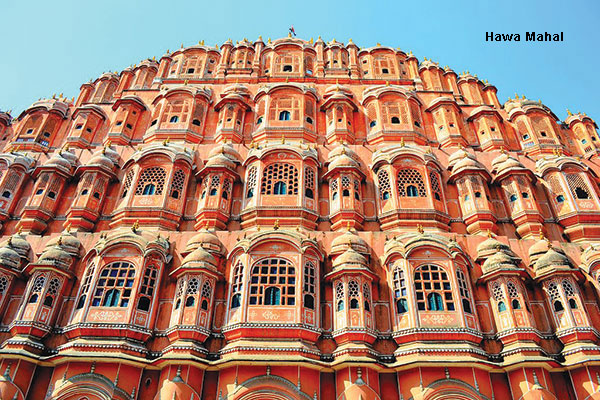
Popularly known as the pink City, after the vibrant colour of buildings in the old quarter, Jaipur is named after its most famous son — warrior-astronomer-king Jai Singh II who built the city in 1727. Designed according to civic construction principles of the shilpa shastra, the city is laid out in rectangular blocks within a surrounding wall and five majestic gates. Inevitably, it has grown out of the confines of the old wall and has transformed into one of the most chaotic and polluted cities of Rajasthan. But its old world charm is ubiquitous. One can still see Rajputs in traditional regalia, sporting bright turbans and swashbuckling moustaches on every street corner.
The Hawa Mahal or Palace of Winds built by Maharaja Sawaj Pratap Singh is Jaipur’s most famous monument. The five-storey building consists of small, delicately honey-combed sandstone windows and is a stunning example of Rajput artistry. It was originally built to enable purdah-clad ladies of the Royal household to monitor everyday life and processions in the city. Not far from Hawa Mahal is another must-see monument — the Iswari Minar Swarga Sal (Heaven Piercing Minaret).
The City Palace complex located in the heart of Jaipur houses the Maharaja Sawai Mansingh II Museum containing a collection of royal costumes, Mubarak Mahal or Welcome Palace, Diwan-I-am or hall of public audience, Diwan-I-khas or hall of private audience and the exquisite Peacock Gate.
Also take in Jantar Mantar, the first observatory in the country, constructed in 1728 by Jai Singh adjacent to the City Palace and Nahargarh known as the Tiger Fort, which overlooks the city from a sheer ridge to the north.
Accommodation. Top-end: The Oberoi Rajvilas (Rs.80,000-11 lakh per night), Rambagh Palace (Rs.40,000-950,000), Jai Mahal Palace Hotel (Rs.18,000-80,000). Mid-range: Madhuban (Rs.2,499-4,199), Umaid Bhawan Guest House (Rs.4,000-5,500), Hotel Meghniwas (Rs.6,000- 7,000), Hotel Pearl Palace (Rs.1,500-2,400), Jaipur Inn (Rs.2,000-3,000). Budget: Atithi Guest House (Rs.1,200-1,400).
Restaurants. There are numerous restaurants located along the arterial Mirza Ismail Road offering Indian, Chinese and continental food. Niro’s, Surya Mahal, Natraj, Handi are rated among the best.
Excursions. From Jaipur popular daytime excursions include Amber (11 km), an imposing hill fort famous for its exquisite mirror ceiling in Jai Mandir; Galta (2.5 km), notable for its frescoes and the Sun temple; Ramgarh (35 km), the royal hunting lodge with a picturesque lake and polo ground.
Udaipur
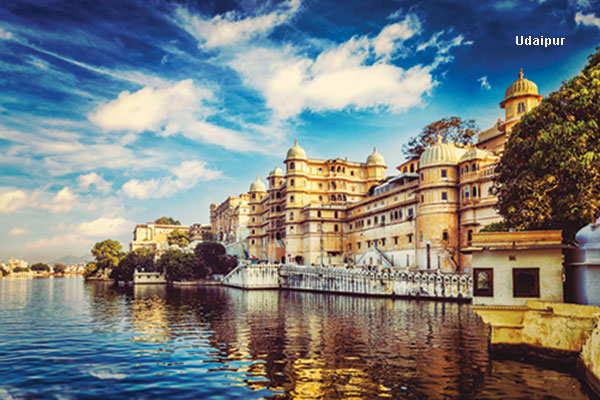
When Emperor Akbar invaded Chittorgarh in 1567, Maharana Udai Singh was forced to establish an alternative capital. On the advice of a sage, Udai Singh built a new city on the banks of lake Pichola, surrounded by the Aravalli hills. The sage predicted that the new capital would never be conquered and it never was. A river was dammed to create huge lakes and provide supplies of fresh water. Udaipur flourished to become Rajasthan’s most gracious city.
A succession of 22 Maharanas added to the original palace, located on a vast property spanning 3 km x 1.5 km on the lakeshore facing east. There are now five separate palaces inside the fort walls, so cohesive in design, they give the impression of a single façade. In Shambu Niwas Palace lives the incumbent Maharana, Shriji Arvind Singh Mewar, the 76th scion of the 1,500-year-old House of Mewar.
A commanding presence on Pichola lake’s two islands are the Lake Palace and Jag Mandir. Lake Palace was built in 1754 as a summer retreat and is now one of the most luxurious hotels of the world. Jag Mandir, built as a pleasure palace in 1622, was used by Prince Khurram (who later assumed the title Shah Jahan) as a royal refuge. Today Jag Mandir serves as a magnificent venue for weddings and a spectacular backdrop for concerts and events.
In 1950 the City Palace was converted into a museum and 20 years ago the Zenana, the Queens’ quarters, was opened to the public as part of the museum. Visitors can now appreciate and enjoy Mewar’s remarkable history. Manak Chowk, the huge courtyard in front of the museum bustles with activity as visitors walk into shops and boutiques or take a break in the café.
The crescent-shaped Shiv Nivas Palace, now a hotel, is the most special part of the complex with regal suites lavishly decorated with royal paintings and other treasures. In 2002 the Fateh Prakash Palace won the National Award for the best Grand Heritage Hotel, and is richly appointed with original paintings and furniture. The gallery surrounding the impressive Durbar Hall in Fateh Prakash Palace houses a grand crystal collection now open for public viewing.
Walk a hundred yards past Tripolia, the magnificent gateway to the Palace complex, to a delightful colonial building which houses the House of Mewar’s Vintage & Classic Car Museum. Hardly 5 km from the City Palace is Shikarbadi, the royal hunting lodge, now a charming chalet-style hotel. At 4 p.m every afternoon just about 100 ft. from the lodge, a guard scatters a sack of grain on the banks of the lake setting off a flurry of excitement as wild birds and animals come out to feed from the surrounding jungle. A delightful sight for sore city-bred eyes.
Accommodation. Top-end: Fateh Prakash Palace Hotel (Rs.20,000-65,000), Shiv Nivas Palace Hotel (Rs.19,000-100,000), Trident (Rs.13, 000-35,000), Taj Lake Palace Hotel (Rs.37,511-110,907). Mid-range: Kankarwa Haveli (Rs.4,100-7,500), Jagat Niwas Palace Hotel (Rs.4,550-16,000), Budget: Poonam Haveli (Rs.2,950). Lalghat Guest House (Rs.1,600-3000), Hotel Gangaur Palace (Rs.1,368). Udaipur also boasts scores of sun-kissed roof top restaurants as well as fine dining places in top-end hotels, offering Indian and western cuisines.
Excursions. There are several places of tourist interest around Udaipur. Among them: the Eklingji temple (22 km) located in a complex of 108 intricately carved temples; Deogarh (135 km) with its 2,000-year-old Anjaneshwar Mahadev temple surrounded by lakes, hills and rugged countryside; Ranakpur (60 km) sited in a remote valley of the Aravalli range and one of the largest and most important Jain temples in India. The main temple here is the four-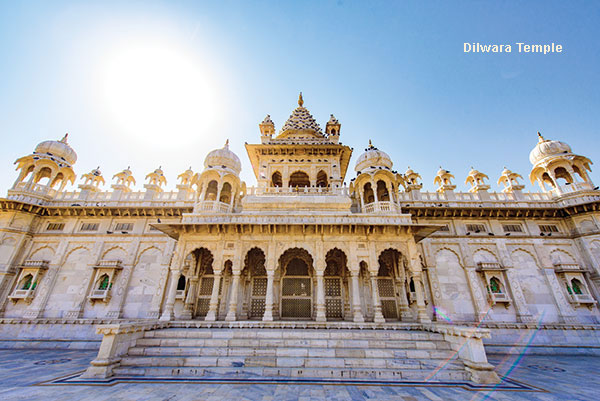 faced Chaumukha with 29 halls supported by 1,444 pillars of which none are alike. Kumbalgarh (84 km) is the most important fort in Mewar, built in 1458 by Raja Rai Singh. The fort is surrounded by a 36-km rampart, the second longest wall in the world after the Great Wall of China.
faced Chaumukha with 29 halls supported by 1,444 pillars of which none are alike. Kumbalgarh (84 km) is the most important fort in Mewar, built in 1458 by Raja Rai Singh. The fort is surrounded by a 36-km rampart, the second longest wall in the world after the Great Wall of China.
Mt. Abu. Located in the far south of the state close to the Gujarat border, Mt. Abu is the only hill station in Rajasthan. The summer festival dedicated to the classical and folk music of Rajasthan is hosted here from June 1-3 every year. The breathtakingly beautiful Dilwara temples located here are an important pilgrim centre for Jains. Nakki lake is another big tourist attraction. According to the legend the lake was scooped out by God using only his nails.
Jaisalmer
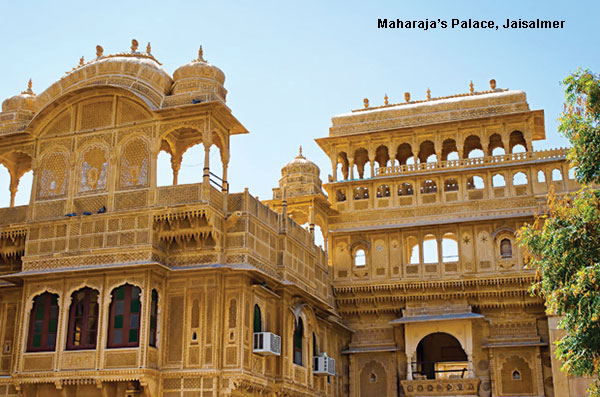
Sited in Western Rajasthan, close to the volatile Indo-Pak border, Jaisalmer is also known as the Golden city because of the colour imparted to its stone ramparts by the setting sun. Tourism rivals the military base as the mainstay of the city’s economy. Jaisalmer fort exudes a fairy tale charm, though at some places it is showing signs of decay. Once you enter the fort you will lose yourself in its labyrinthine streets and bazaars. Built atop the 80-metre tall Trikuta hill in 1156 by Jaisala, a Rajput ruler, the fort has 99 bastions around its circumference.
There are seven beautifully carved Jain temples located within the fort which date back to the 12th and 15th centuries. The temples abound in hand carvings of Jain tirthankaras, hewn from the region’s distinctive yellow stone and are connected by a series of corridors and walkways. Only two of these temples are accessible to non-Jains.
When in Jaisalmer visit the Laxminath temple, the several beautiful havelis or mansions built by wealthy merchants in the past centuries; the Gadi Sagar tank located in the south of the city which is a birdwatcher’s delight. The Desert Culture Centre & Museum with its impressive collection of textiles, old coins, Rajasthani musical instruments and the Government Museum located in the heart of the city are some other places of interest.
Jaisalmer hosts the Desert Festival from February 6-8 every year. The highlights of this festival are the camel fair and a turban tying competition which is a huge draw with tourists.
Accommodation. Top-end: Rang Mahal (Rs.4,500-12,000), Gorbandh Palace Hotel (Rs.9,676-12,000), Jawahar Niwas Palace (Rs.10,000-12,857), Mandir Palace Hotel (Rs.7,000-22, 000). Mid-range: Desert Boy’s Guest House (Rs.2,658-4,023), Hotel Jaisal Castle (Rs.3,500). Budget: Hotel Renuka (Rs.560-1,560), Hotel Swastika (Rs.600-1,200).
Excursions. There are several excursions visitors can take ex Jaisalmer. Among them: the ruins of Lodhruva (15 km); Sam Sand Dunes (42 km), a desert national park; Barmer (153 km), famous for woodcarvings, carpets, embroidery, block printing and other handicrafts; Pokaran, the site of nuclear tests and Khichan, a must-see destination for bird-watchers and wildlife enthusiasts.
Camel safari. A visit to Rajasthan would be incomplete without a camel safari — the best way to sample desert life. The ideal time to go on safari is from October to February. Most camel safaris last three to four days.
Bikaner
A desert city in North Rajasthan, Bikaner is famous for the stately Junagarh Fort. A seven-kilometre long perimeter wall with five entrance gates encircles the old city founded in 1488 by Rao Bika. Other places of interest in Bikaner are Lalgarh Palace and the Ganga Government Museum.
Accommodation. Top-end: Hotel Bhanwar Niwas (Rs.6,000-9,000), The Lallgarh Palace Hotel (Rs.5,000-17,000), Karni Bhawan Palace Hotel (Rs.3,000 onwards). Mid-range: Bhairon Vilas (Rs.1,365-4,095), Hotel Palace View (Rs.790-1,221), Hotel Padmini Niwas (Rs.800 onwards). Budget: Hotel Meghsar Castle (Rs.250-300), Hotel Kishan Palace (Rs.150-300).
Also Read: Also Read: Hampi – testimony to a golden age

























